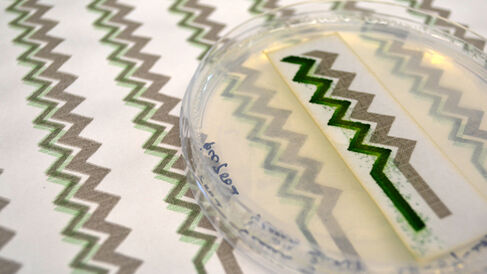
The Howe Group and their collaborators have published a paper in Nature Communications demonstrating that printed cyanobacteria can be used as a two-in-one bio-battery and bio-solar-panel.
The search for renewable energy technology is of utmost importance with our continuing depletion of fossil fuel sources and the world's increasing population. As a result, in the last few years there has been significant interest in using microbes to produce electricity in 'green-electronics'.1 This work has mainly focused on heterotrophic bacteria. Like humans, these microorganisms absorb organic, carbon-containing compounds through eating plant and animal matter, which is then metabolised and broken down to ultimately release electrons and create an electrical output. The obvious drawback of these microbial fuel cells, however, is that the green-electronics would require 'feeding' with a sustained supply of carbon sources.2-3
Recently, photosynthetic cyanobacteria and single-celled algae have successfully been used to produce a type of microbial fuel cell that functions without added carbon feedstock; biophotovoltaic (BPV) cells. In the light, BPV cells release electrons and produce an electrical output using light energy and photosynthesis (a bio-solar-panel), whilst in the dark the electrical current is maintained through breakdown of photosynthetic products by respiration (a bio-battery).4-6
BPV cells are conventionally produced using gravity to deposit bacteria on to an electrode surface from a liquid culture.4,6 However, this process creates problems with scalability and mass-production as deposition is a lengthy process, there is minimal scope for engineering of the electrode, and the products are necessarily bulky due to the presence of the liquid culture reservoir. In addition, these BPV cells are expensive and have a low power output and short lifespan.7-9
In their article, Marin Sawa (Central Saint Martins and Imperial College London) and collaborators, including Dr Paolo Bombelli in Professor Howe's group, demonstrate that a standard inkjet printer can be used to print both cyanobacteria and electrically conductive carbon nanotubes onto paper, creating a bespoke BPV cell. Critically, cyanobacteria remain fully viable and suffer no loss of photosynthetic capacity after printing, meaning printed BPV cells produce an electrical current similar to conventionally-manufactured cells. In experiments, printed BPV cells around the size of an iPad maintained electrical output for over 100 hours, and could power a digital clock or a small LED lightbulb.
In the future, this printing of bioelectrodes onto paper could lead to novel electrical devices with wide-ranging applications: from disposable and biodegradable biosensors that monitor health indicators such as blood glucose levels in patients with diabetes, to wallpaper that monitors air quality in the home. Professor Howe commented that: "This is an exciting proof-of-concept. The challenge now is to make panels that are more powerful, long-lasting and robust."
1Choi, Biosens. Bioelectron. 69:8, 2015.
2Logan and Rabaey, Science337:686, 2012.
3Logan et al., Environ. Sci. Technol. Lett. 2:206, 2015.
4Rosenbaum et al., Curr. Opin. Biotechnol. 21:259, 2010.
5Wang et al., Nano Energy 8:264, 2014.
6McCormick et al., Energy Environ. Sci. 8:1092, 2015.
7Ren et al., Microfluid. Nanofluidics 13:353, 2012.
8Wang et al., Bioresour. Technol.102:235, 2011.
9Kim et al., ChemSusChem 5:1086, 2012.
